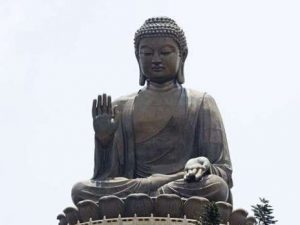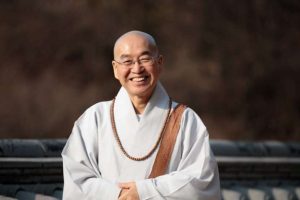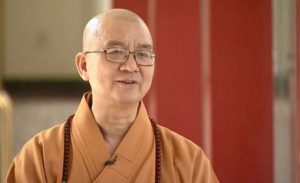
Meditative practitioners are entitled to rebirth in the Pure Land
In the Contemplation Sutra, Queen Vaidehi asks Shakyamuni Buddha to teach her how to meditate and visualize the heaven of pure karma in order to attain rebirth there. However, after the Buddha shows her splendid scenes of Amitabha’s Land of Bliss, Vaidehi asks Shakyamuni Buddha to teach her higher states of samadhi in order to visualize the Land of Bliss and thus attain rebirth there instead: “I beseech you to teach me how to perceive (prior to contemplation) [that land] and teach me how to attain samadhi.”
In his Commentary on the Contemplation Sutra, Master Shandao describes Queen Vaidehi’s requests as being founded in “unripe karmic circumstances and incomplete revelation in practice.”
Unlike rebirth in the heavenly realms, rebirth in the Land of Bliss is not a privilege reserved solely for practitioners capable of attaining higher meditative states. Even if one follows the first thirteen of the Sixteen Contemplations in the Contemplation Sutra (thirteen of the contemplations are meditative practices, while three are non-meditative practices) step by step and achieves the samadhi of Buddha-contemplation, one does not automatically “qualify” to be reborn in the Land of Bliss.
Pure Land aspirants who achieve any one of the first thirteen contemplations are also required to single-mindedly dedicate their meditative virtues and sincerely aspire to be reborn in Amitabha’s Land of Bliss. In this way, meditative practitioners take the meditative virtues as their main cause of rebirth in the Pure Land and the first thirteen contemplations as their main practice for attaining rebirth there.
This is the first way to attain rebirth in the Land of Bliss and the most difficult. Only those who have the divine eye and can see distant realms will succeed in undertaking such arduous contemplative practices. Shakyamuni Buddha immediately discourages Queen Vaidehi from taking the meditative approach: “You are unenlightened, so your spiritual powers are weak and obscured. Since you have not yet attained the divine eye, you cannot see that which is distant.”
Non-meditative practitioners are also entitled to rebirth in the Pure Land
Shakyamuni Buddha then tells Queen Vaidehi that an ordinary being practicing pure karma with non-meditative virtues can also be reborn in the Pure Land. The Buddha says, “All ordinary people in the future who wish to practice pure karma may also be reborn in the Western Land of Bliss. Whoever wishes to be reborn there should practice the Three Meritorious Deeds.” *
In the Contemplation Sutra, Shakyamuni Buddha further classifies the three tiers of non-meditative practitioners into nine levels. In doing so, he shows their aptitude and their attainment of merit, virtues of cultivation, precepts, and worldly morality through self-powered non-meditative practices.
Master Shandao says in his Commentary on the Contemplation Sutra: “Furthermore, when we study the meaning of the passage concerning meditative virtues and the three tiers, it refers exclusively to ordinary beings in the world of five defilements after the Buddha has passed away. They are classified into nine levels because of differences in their karmic circumstances. What does this mean? The three kinds of people in the upper tier are those who encounter the Mahayana teachings. The three kinds of people in the middle tier are those who encounter the Theravada teachings. The three kinds of people in the lower tier are those who encounter evil circumstances.”
The second way to attain rebirth in Amitabha’s Land of Bliss is for those who take the Three Meritorious Deeds (the non-meditative virtues) as the main cause of rebirth, and the karmic practices listed in the last three contemplations (the nine levels of aptitude) as the main practice for rebirth, as stated by Master Shandao. Again, practitioners corresponding to any of the nine levels of aptitude can achieve rebirth in this way, but they have to dedicate their merit and aspire accordingly if they wish to be reborn in the Land of Bliss, similar to the first way.
Those who are neither meditative nor non-meditative practitioners can also be reborn in the Pure Land
It is interesting to note that in the last contemplation, the three kinds of people in the lower tier—who encounter evil circumstances and have no merit or virtues at all—simply have nothing to dedicate. How can they be reborn in the Land of Bliss if they aspire to?
Master Shandao says, “Due to their evil karma, they have to rely on a good teacher and avail themselves of the power of the Buddha’s vow to be reborn [in the Pure Land].” This is the third way stipulated in the Contemplation Sutra to attain rebirth in Amitabha’s Land of Bliss for those who take the Three States of Mind** as the main cause of rebirth, and Amitabha-invocation as the main practice for rebirth, as indicated by Master Shandao.
This is the easiest of the three ways. Though it is described as the lower tier in the Contemplation Sutra, this way applies to all sentient beings, including meditative and non-meditative practitioners. Even the worst people—those of the lowest level of the lower tier under the worst karmic circumstances—can attain rebirth through Amitabha-invocation. As such, sentient beings practicing any of the Thirteen Contemplations or those at any of the nine levels of non-meditative practice can use this method and exclusively practice Amitabha-recitation to seek rebirth. This method is the underlying intent of Shakyamuni Buddha in speaking of the Sixteen Contemplations throughout the Contemplation Sutra, so it is highly recommended by Shakyamuni Buddha.
Master Shandao explains: “Though [Shakyamuni Buddha] has spoken of the benefits [of attaining rebirth] through practicing the meditative and non-meditative virtues, his intention, in accord with [Amitabha] Buddha’s Fundamental Vow, is for sentient beings to exclusively recite the name of Amitabha Buddha in a consistent and persistent manner.” All Pure Land aspirants should comply with Shakyamuni Buddha’s intent and exclusively recite the name of Amitabha Buddha in a consistent and persistent manner in order to attain rebirth in his Pure Land.
* The Three Meritorious Deeds:
1. Caring for one’s parents, attending to one’s teachers and elders, compassionately refraining from killing, and doing the Ten Good Deeds.
2. Taking the three refuges, keeping the various precepts, and refraining from breaking the rules of conduct.
3. Awakening the aspiration for enlightenment, believing deeply in the law of causality, chanting the Mahayana sutras, and encouraging people to follow their teachings.
These are usually called the virtues of worldly morality (moral conduct for non-Buddhists), the virtues of precepts (Theravada Buddhist practices), and the virtues of cultivation (Mahayana Buddhist practices), respectively.
** The Three States of Mind:
1. The Sincere Mind
2. The Deep Mind
3. The Mind of Merit-dedication and Rebirth-aspiration
See more
A Comparison of the Two Ways of Seeing Amitabha Buddha and Attaining Rebirth in His Pure Land (Buddhistdoor Global)
How to See Amitabha Buddha and Attain Rebirth in the Pure Land Through Name-recitation (Buddhistdoor Global)
Two Ways to See Amitabha Buddha (Buddhistdoor Global)
Shakyamuni Buddha’s Responses to the Three Requests of Queen Vaidehi (Buddhistdoor Global)











